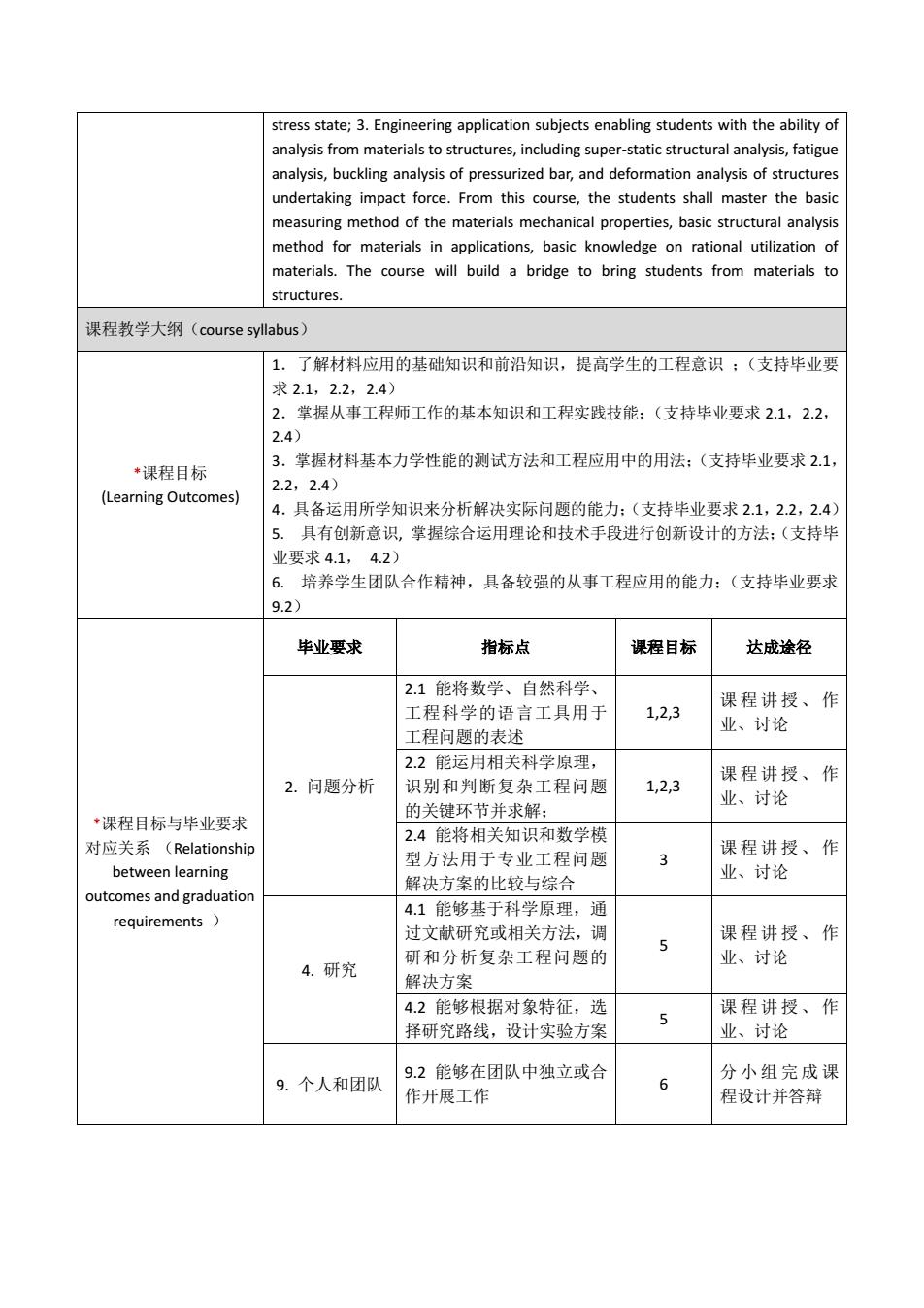正在加载图片...

stress state;3.Engineering application subjects enabling students with the ability of analysis from materials to structures,including super-static structural analysis,fatigue analysis,buckling analysis of pressurized bar,and deformation analysis of structures undertaking impact force.From this course,the students shall master the basic measuring method of the materials mechanical properties,basic structural analysis method for materials in applications,basic knowledge on rational utilization of materials.The course will build a bridge to bring students from materials to structures. 课程教学大纲(course syllabus) 1.了解材料应用的基础知识和前沿知识,提高学生的工程意识:(支持毕业要 求2.1,2.2,2.4) 2.掌握从事工程师工作的基本知识和工程实践技能:(支持毕业要求2.1,2.2, 2.4) 3.掌握材料基本力学性能的测试方法和工程应用中的用法:(支持毕业要求2.1, *课程目标 2.2,2.4) (Learning Outcomes) 4.具备运用所学知识来分析解决实际问题的能力:(支持毕业要求2.1,2.2,2.4) 5. 具有创新意识,掌握综合运用理论和技术手段进行创新设计的方法:(支持毕 业要求4.1,4.2) 6. 培养学生团队合作精神,具备较强的从事工程应用的能力:(支持毕业要求 9.2) 毕业要求 指标点 课程目标 达成途径 2.1能将数学、自然科学、 课程讲授、作 工程科学的语言工具用于 1,2,3 工程问题的表述 业、讨论 2.2能运用相关科学原理, 课程讲授、作 2.问题分析 识别和判断复杂工程问题 1,2,3 业、讨论 的关键环节并求解: *课程目标与毕业要求 2.4能将相关知识和数学模 对应关系(Relationship 型方法用于专业工程问题 课程讲授、作 3 between learning 解决方案的比较与综合 业、讨论 outcomes and graduation 4.1能够基于科学原理,通 requirements 过文献研究或相关方法,调 课程讲授、作 5 研和分析复杂工程问题的 业、讨论 4.研究 解决方案 4.2能够根据对象特征,选 课程讲授、作 择研究路线,设计实验方案 业、讨论 9.2能够在团队中独立或合 分小组完成课 9.个人和团队 作开展工作 程设计并答辩stress state; 3. Engineering application subjects enabling students with the ability of analysis from materials to structures, including super-static structural analysis, fatigue analysis, buckling analysis of pressurized bar, and deformation analysis of structures undertaking impact force. From this course, the students shall master the basic measuring method of the materials mechanical properties, basic structural analysis method for materials in applications, basic knowledge on rational utilization of materials. The course will build a bridge to bring students from materials to structures. 课程教学大纲(course syllabus) *课程目标 (Learning Outcomes) 1.了解材料应用的基础知识和前沿知识,提高学生的工程意识 ;(支持毕业要 求 2.1,2.2,2.4) 2.掌握从事工程师工作的基本知识和工程实践技能;(支持毕业要求 2.1,2.2, 2.4) 3.掌握材料基本力学性能的测试方法和工程应用中的用法;(支持毕业要求 2.1, 2.2,2.4) 4.具备运用所学知识来分析解决实际问题的能力;(支持毕业要求 2.1,2.2,2.4) 5. 具有创新意识, 掌握综合运用理论和技术手段进行创新设计的方法;(支持毕 业要求 4.1, 4.2) 6. 培养学生团队合作精神,具备较强的从事工程应用的能力;(支持毕业要求 9.2) *课程目标与毕业要求 对应关系 (Relationship between learning outcomes and graduation requirements ) 毕业要求 指标点 课程目标 达成途径 2. 问题分析 2.1 能将数学、自然科学、 工程科学的语言工具用于 工程问题的表述 1,2,3 课 程 讲 授 、 作 业、讨论 2.2 能运用相关科学原理, 识别和判断复杂工程问题 的关键环节并求解; 1,2,3 课 程 讲 授 、 作 业、讨论 2.4 能将相关知识和数学模 型方法用于专业工程问题 解决方案的比较与综合 3 课 程 讲 授 、 作 业、讨论 4. 研究 4.1 能够基于科学原理,通 过文献研究或相关方法,调 研和分析复杂工程问题的 解决方案 5 课 程 讲 授 、 作 业、讨论 4.2 能够根据对象特征,选 择研究路线,设计实验方案 5 课 程 讲 授 、 作 业、讨论 9. 个人和团队 9.2 能够在团队中独立或合 作开展工作 6 分 小 组 完 成 课 程设计并答辩